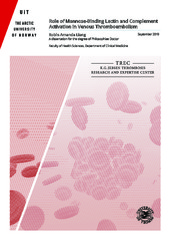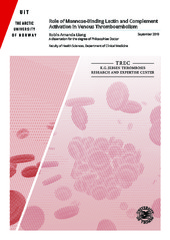| dc.contributor.advisor | Hansen, John-Bjarne | |
| dc.contributor.author | Liang, Robin Amanda | |
| dc.date.accessioned | 2020-01-07T22:23:33Z | |
| dc.date.available | 2020-01-07T22:23:33Z | |
| dc.date.issued | 2019-12-17 | |
| dc.description.abstract | The complement and coagulation systems are two interrelated plasma protein cascades. Evidence from observational and animal studies has proposed a role for the complement system in the development of venous thromboembolism (VTE), but the exact mechanisms remain obscure.
The aim of this thesis was to investigate whether activation of the complement system impacts the risk of VTE and to investigate which pathways may be involved. The procoagulant properties of the lectin pathway, in particular, demanded closer inspection. Genetic variations associated with plasma levels of complement protein or activation products were also explored to discover novel genetic regulators that could potentially contribute to thrombosis risk.
The fourth survey of the Tromsø Study was used as the parent cohort for all of the nested case-control studies discussed in this thesis. There were 462 individuals who experienced a VTE in the follow-up period (1994/95-2007). For each VTE case, two age- and sex-matched controls who were alive at the index date of the VTE event were randomly sampled from the source cohort.
The findings in this thesis support a role for the complement system in the development of VTE. Higher baseline levels of complement activation as measured by the soluble terminal C5b-9 complement complex (TCC) were associated with future risk of VTE, as were high levels of plasma mannose-binding lectin (MBL). The rs8176719 SNP of the ABO gene, which determines O and non-O blood types and is itself a known risk factor for VTE, was found to be significantly associated with high plasma MBL levels. Individuals with high plasma MBL levels and type O blood were found to have a similar risk for VTE as individuals with non-O blood type, regardless of plasma MBL levels.
These studies implicate that the lectin pathway is involved in the mechanisms leading to venous thrombosis. Functional studies are warranted. Additionally, the discovery of a relationship between blood type and plasma MBL levels requires further investigation, both alone and as a risk factor for venous thromboembolism. | en_US |
| dc.description.doctoraltype | ph.d. | en_US |
| dc.description.popularabstract | Venous thromboembolism (VTE), a disease spectrum including deep vein thrombosis and pulmonary embolism, is a serious and complex disease. It is also a common disease, with an annual incidence of 1-2 per 1000 persons. As it is accompanied by many grave short- and long-term complications, venous thromboembolism presents a large public health burden. The mechanisms behind this disease remain elusive. Despite great efforts to increase awareness and improve prevention of the disease, the incidence of VTE has remained stable or even increased slightly over the last few decades. The discovery of new mechanisms and potential biomarkers is therefore crucial for the development of new treatment and prevention strategies.
The coagulation system is responsible for stopping bleeding by clot formation at the site of injury. Excessive activation or dysregulation of the coagulation system results in inappropriate clot formation, called thrombosis. The coagulation cascade works closely with the complement system, another protein system in the blood plasma. Important functions of the complement system include integration of the innate and adaptive immune systems, development of tissues and organs, and the promotion of tissue repair. As the complement and coagulation systems are interlinked through several molecular mechanisms, dysregulation of the complement system also affects the coagulation system. Recent animal and in vitro studies support a role for the complement system in thrombogenesis.
While many studies have investigated the role of the complement system in arterial cardiovascular disease, few have investigated its role in venous thromboembolism. This thesis explores the role of the complement system in the development of venous thrombosis, and seeks to investigate potentially prothrombotic mechanisms involved. | en_US |
| dc.description.sponsorship | Stiftelsen K.G. Jebsen | en_US |
| dc.identifier.uri | https://hdl.handle.net/10037/17027 | |
| dc.language.iso | eng | en_US |
| dc.publisher | UiT The Arctic University of Norway | en_US |
| dc.publisher | UiT Norges arktiske universitet | en_US |
| dc.relation.haspart | <p>Paper I: Høiland, I.I., Liang, R.A., Brækkan, S.K., Pettersen, K., Ludviksen, J.K., Latysheva, N., … Hansen, J.B. (2019). Complement Activation Assessed by the Plasma Terminal Complement Complex and Future Risk of Venous Thromboembolism. <i>Journal of Thrombosis and Haemostasis, 17</i>(6), 934-943. Also available at <a href= https://doi.org/10.1111/jth.14438> https://doi.org/10.1111/jth.14438</a>.
<p>Paper II: Liang, R.A., Høiland, I.I., Ueland, T., Aukrust, P., Snir, O., Hindberg, K., … Hansen, J.B. (2019). Plasma levels of Mannose-Binding Lectin and Future Risk of Venous Thromboembolism. <i>Journal of Thrombosis and Haemostasis, 17</i>(10), 1661-1669. Also available in Munin at <a href=https://hdl.handle.net/10037/16191> https://hdl.handle.net/10037/16191</a>.
<p>Paper III: Liang, R.A., Hindberg, K., Ueland, T., Aukrust, P., Snir, O., Brækkan, S.K., … Hansen, J.B. ABO Status Affects Plasma Mannose-Binding Lectin Levels and the Association Between MBL Levels and Risk of Venous Thromboembolism. (Manuscript). Available in the file “thesis_entire.pdf”. | en_US |
| dc.relation.isbasedon | The Tromsø Study (Tromsø 4)
data sets available upon request | en_US |
| dc.rights.accessRights | openAccess | en_US |
| dc.rights.holder | Copyright 2019 The Author(s) | |
| dc.rights.uri | https://creativecommons.org/licenses/by-nc-sa/4.0 | en_US |
| dc.rights | Attribution-NonCommercial-ShareAlike 4.0 International (CC BY-NC-SA 4.0) | en_US |
| dc.subject | VDP::Medical disciplines: 700::Clinical medical disciplines: 750::Hematology: 775 | en_US |
| dc.subject | VDP::Medisinske Fag: 700::Klinisk medisinske fag: 750::Hematologi: 775 | en_US |
| dc.title | Role of Mannose-Binding Lectin and Complement Activation in Venous Thromboembolism | en_US |
| dc.type | Doctoral thesis | en_US |
| dc.type | Doktorgradsavhandling | en_US |


 English
English norsk
norsk

